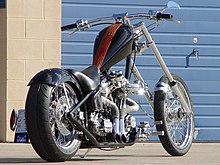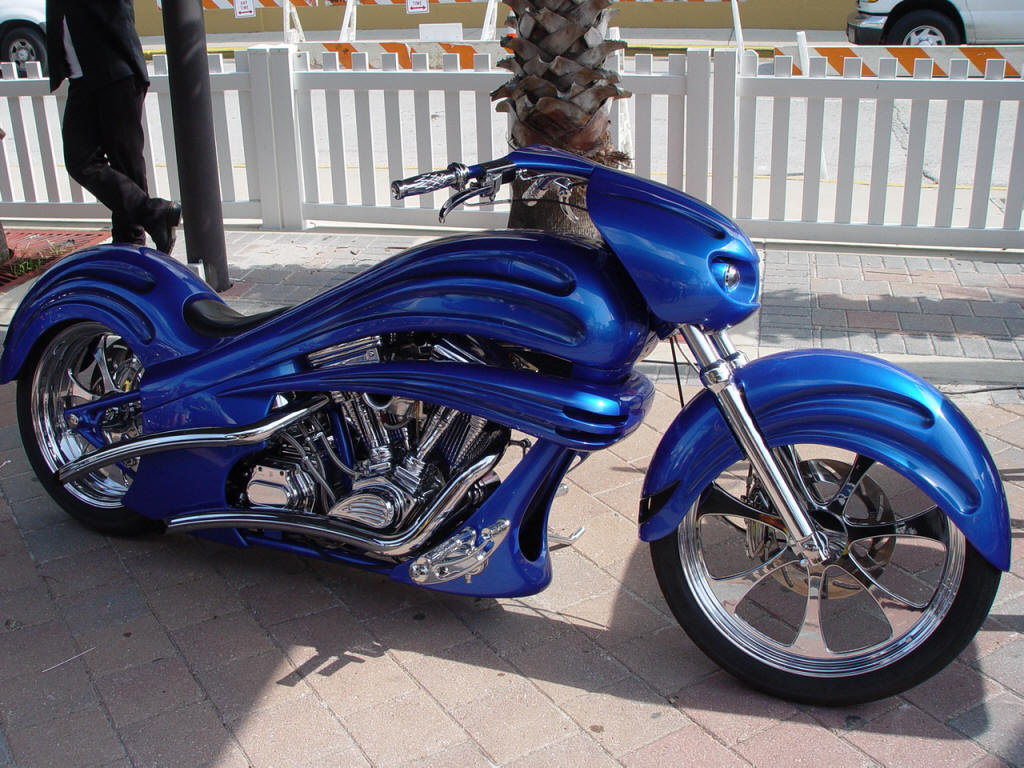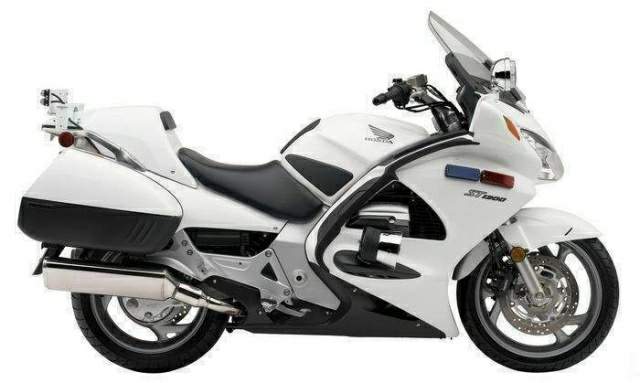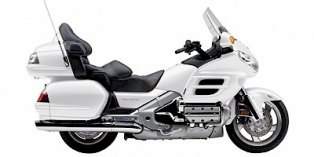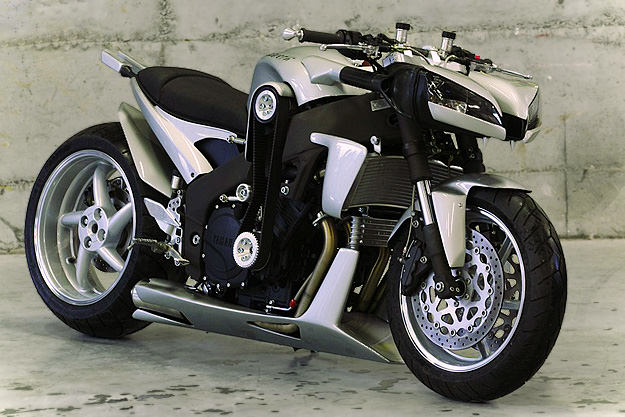SUZUKI Motorcycle Modificatio: Detroit Mini Choppers
Designed as a tribute to the classic chopper, the “Fallout” by William Woods
Motorcycle Modification and Picture Modifications
Yamaha Mio Motorcycle Gold Color Modification · Classic American Chopper
A chopper is a radically customized motorcycle, archetypal examples of which are the customized Harley-Davidsons seen in the 1969 film Easy Rider. so after you know the definition of the chopper itself. now why don’t we take a closer look to the most extreme chopper modifications...
While people assume that the chopper style motorcycles were built purely for aesthetics, there is a real performance advantage to the raked front end on these choppers. These motorcycles have a much more stable feel at high speeds and in a straight line than motorcycles with original factory front suspensions. However, like any other modification, there is a downside: the raked front end feels heavier and less responsive at slow speeds or in curves and turns. This is due to the longer trail measurement associated with increased rake.
Here’s the most extreme chopper modifications ever.. if you was the lover of chopper style this picture below might be a great inspiration for you before you modify your chopper style motorcycle…
While people assume that the chopper style motorcycles were built purely for aesthetics, there is a real performance advantage to the raked front end on these choppers. These motorcycles have a much more stable feel at high speeds and in a straight line than motorcycles with original factory front suspensions. However, like any other modification, there is a downside: the raked front end feels heavier and less responsive at slow speeds or in curves and turns. This is due to the longer trail measurement associated with increased rake.
Here’s the most extreme chopper modifications ever.. if you was the lover of chopper style this picture below might be a great inspiration for you before you modify your chopper style motorcycle…
New Motorcycle M-Org Concept chopper – the most “green” of all green
Best Harley Chopper Modification Collection 2009
A chopper is a type of motorcycle that was either modified from an original motorcycle design ("chopped") or built from scratch to have an authentic appearance. The main features of a chopper that make it stand out are its longer frame design accompanied by a stretch front end (or rake). To achieve a longer front end, while the frame is being designed, the fabricator will tilt the neck of the frame at less of an incline and install a longer fork. Another unique aspect of a chopper design is that there is usually no rear suspension meaning the frame of the motorcycle will extend from the neck (or front of the frame) all the way to the rear wheel. This can make handling the motorcycle more challenging and the ride a bit more "bumpy". These attributes may seem radical to some but is necessary for the look that is desired. One look that is becoming more popular with chopper designs is a low frame to ground clearance or a low-rider look. Well known examples of chopper designs are the customized Harley-Davidsons seen in the 1969 film Easy Rider.
History
Before there were choppers, there was the bobber, meaning a motorcycle that had been "bobbed," or relieved of excess weight by removing parts, particularly the fenders, with the intent of making it lighter and thus faster, or at least making it look better in the eyes of a rider seeking a more minimalist ride.[1] An early example of a bobber is the 1940 Indian Sport Scout "Bob-Job" which toured in the 1998 The Art of the Motorcycle exhibition.[2][3] Indian Scouts and Chiefs of the time came with extravagantly large, heavily valenced fenders, nearly reaching the center of the wheel on the luxurious 1941 Indian Series 441[4] while racing bikes had tiny fenders or none at all. The large and well-appointed bikes exemplified the "dresser" [1] motorcycle aesthetic and providing a counterpoint to the minimalist bobber, and cafe racers. Choppers would grow into and explore the dimensions of the space between the stripped-down bobbers and weighed-down dressers.
In the post-World War II United States, servicemen returning home from the war started removing all parts deemed too big, heavy, ugly or not absolutely essential to the basic function of the motorcycle, such as fenders, turn indicators, and even front brakes. The large, spring-suspended saddles were also removed in order to sit as low as possible on the motorcycle's frame. These machines were lightened to improve performance for dirt-track racing and mud racing.[3][5]
Forward-mounted foot pegs replaced the standard large 'floorboard' foot rests. Also, the standard larger front tire, headlight and fuel tank were replaced with much smaller ones. Many choppers were painted preferably all in either flat black or in shiny metallic “metal flake” colors. Also common were many chromed parts (either one-off fabricated replacements or manually chromed stock parts). According to the taste and purse of the owner, “chop shops” would build high handle bars, or later “Big Daddy” Roth Wild Child’s designed stretched, narrowed, and raked front forks. Shops also custom built exhaust pipes and many of the “after market kits“ followed in the late 1960s into the 1970s. Laws required (and in many locales still do) a retention fixture for the passenger, so vertical backrests called sissy bars were a popular installation, often sticking up higher than the rider's head.
While the decreased weight and lower seat position improved handling and performance, the main reason to build such a chopper was to show off and provoke others by riding a machine that was stripped and almost nude compared to the softer-styled stock Harley-Davidsons, let alone the oversized automobiles of that time.
In the post-World War II United States, servicemen returning home from the war started removing all parts deemed too big, heavy, ugly or not absolutely essential to the basic function of the motorcycle, such as fenders, turn indicators, and even front brakes. The large, spring-suspended saddles were also removed in order to sit as low as possible on the motorcycle's frame. These machines were lightened to improve performance for dirt-track racing and mud racing.[3][5]
Forward-mounted foot pegs replaced the standard large 'floorboard' foot rests. Also, the standard larger front tire, headlight and fuel tank were replaced with much smaller ones. Many choppers were painted preferably all in either flat black or in shiny metallic “metal flake” colors. Also common were many chromed parts (either one-off fabricated replacements or manually chromed stock parts). According to the taste and purse of the owner, “chop shops” would build high handle bars, or later “Big Daddy” Roth Wild Child’s designed stretched, narrowed, and raked front forks. Shops also custom built exhaust pipes and many of the “after market kits“ followed in the late 1960s into the 1970s. Laws required (and in many locales still do) a retention fixture for the passenger, so vertical backrests called sissy bars were a popular installation, often sticking up higher than the rider's head.
While the decreased weight and lower seat position improved handling and performance, the main reason to build such a chopper was to show off and provoke others by riding a machine that was stripped and almost nude compared to the softer-styled stock Harley-Davidsons, let alone the oversized automobiles of that time.
An example of a stock 1940's Indian Scout that came with very large fenders.
Traditional choppers
See Some Cool Rides that Were Away From the Traditional Chopper Style.
In the United States servicemen returning from World War II were looking for a thrill. Many veterans had been trained to work on automobiles and motorcycles and were looking to add a little excitement to their post-war lives with their newly acquired mechanical skills. Motorcycles and Hot Rods were the perfect hobby for them. Motorcyclists bought up surplus military bikes and removed all the unnecessary parts such as windshields and saddlebags to minimise weight. Rear fenders were "bobbed" or shortened just enough to handle a passenger and keep the rain and mud coming off the rear, and sometimes removed the mirrors, or replaced them with tiny ones, such as the type used by dentists in their work.
This type of home customization led to the rise of the "bobber". Then in the 60s, motorcyclists found that a longer front end allowed the bike to run smoother at faster speeds. The degree of neck rake and length of front end was modified on these bikes with this in mind. The Girder and Springer front ends were the most popular forks for extending in this fashion, although this does make the bike harder to handle at slower speeds. Nevertheless, some choppers have extremely long forks; as one biker said, "You couldn't turn very good but you sure looked good doing it." [6][7]
To build or chop a traditional chopper an unmodified factory bike is used (usually a rigid Harley Davidson) and everything unnecessary to either move or stop is stripped or chopped off. Then the engine and transmission are removed and the frame is cut up and welded back together to make it lower and lighter. Performance parts are added or modified to increase speed.
This type of home customization led to the rise of the "bobber". Then in the 60s, motorcyclists found that a longer front end allowed the bike to run smoother at faster speeds. The degree of neck rake and length of front end was modified on these bikes with this in mind. The Girder and Springer front ends were the most popular forks for extending in this fashion, although this does make the bike harder to handle at slower speeds. Nevertheless, some choppers have extremely long forks; as one biker said, "You couldn't turn very good but you sure looked good doing it." [6][7]
To build or chop a traditional chopper an unmodified factory bike is used (usually a rigid Harley Davidson) and everything unnecessary to either move or stop is stripped or chopped off. Then the engine and transmission are removed and the frame is cut up and welded back together to make it lower and lighter. Performance parts are added or modified to increase speed.
Today's chopper era
Choppers have enjoyed a large following. Companies like Jesse G. James' West Coast Choppers have been successful in producing expensive traditional chopper-style bikes and a wide range of chopper-themed brands of merchandise such as clothing, automobile accessories and stickers.
A distinction should be noted between true chopper (or chopper-style) motorcycles, and custom motorcycles, or 'custom cruisers'. Despite the name, a large percentage of the motorcycles produced by popular companies such as Orange County Choppers, Indian Larry, Falcon Motorcycles, and Von Dutch Kustom Cycles are better described as 'custom' bikes rather than choppers.
A distinction should also be made between choppers and bobbers. While both tried to improve performance by removing any part that did not make the motorcycle perform better, they differed in an important way: bobbers kept the original factory frame, while choppers have a modified form of the factory frame.
When individuals were stripping their stock motorcycles and bobbing their fenders, the term "bobber" was born. When individuals started cutting (or chopping) and welding their frames thereby repositioning/restyling them, the term "chopper" was born. Chopping was the next phase in the evolution that followed dirt track bobbing.
While people assume that the chopper style motorcycles were built purely for aesthetics, there is a real performance advantage to the raked front end on these choppers. These motorcycles have a much more stable feel at high speeds and in a straight line than motorcycles with original factory front suspensions. However, like any other modification, there is a downside: the raked front end feels heavier and less responsive at slow speeds or in curves and turns. This is due to the longer trail measurement associated with increased rake.
Changing the rake and trail of a motorcycle design requires modification of the design itself. This is a job that requires in-depth input from a motorcycle designer who is experienced with such design changes. A triple tree can be raked, or designed so the lower tree sticks out further than the upper tree, thus increasing the rake of the forks in relation to the steering head rake. What this does, is position the axle closer to the frame rake measurement line, or shortening the trail. Thus, when adding raked trees to a raked frame (which sports a longer trail), the trail is shortened to a more manageable level. Adding raked trees to a frame with short rake and trail can be hazardous, as shortening an already short trail measurement can lead to an unstable situation as speed increases.
Despite the personalized nature of choppers, and the wide availability of alternative designs, chopper builders have overwhelmingly chosen fat rear tires, a rigid-looking frame (even for a softail), and an original or replica air-cooled, pushrod v-twin engine. In the UK, due to the cost and lack of availability of the v-twin engine, many chose to use British engines from bikes such as Triumph or BSA; lately as availability has increased, Japanese engines have seen more use. Some people feel that the variety of engines and other components used more recently (especially on bikes built outside of the US) is diluting the signature appearance of the chopper style. Modern bobber builders tend to distinguish themselves from chopper builders with bikes styled before the chopper era. Modern bobber builder Jan Bachleda in Colorado builds custom choppers and bobbers using Triumph engines and frames from the 1970s and earlier. The look, though chopped, is distinctly modern and low. Today's custom choppers are usually seen as center pieces at bike night events around the United States.[8]
The United States of America, where most custom choppers reside, is one of the few countries in the world that allow custom-built choppers to be licensed for highway use. Many of these types of choppers are regarded as dangerous to operate and don't follow basic design geometry and lack many safety features in their construction.
A distinction should be noted between true chopper (or chopper-style) motorcycles, and custom motorcycles, or 'custom cruisers'. Despite the name, a large percentage of the motorcycles produced by popular companies such as Orange County Choppers, Indian Larry, Falcon Motorcycles, and Von Dutch Kustom Cycles are better described as 'custom' bikes rather than choppers.
A distinction should also be made between choppers and bobbers. While both tried to improve performance by removing any part that did not make the motorcycle perform better, they differed in an important way: bobbers kept the original factory frame, while choppers have a modified form of the factory frame.
When individuals were stripping their stock motorcycles and bobbing their fenders, the term "bobber" was born. When individuals started cutting (or chopping) and welding their frames thereby repositioning/restyling them, the term "chopper" was born. Chopping was the next phase in the evolution that followed dirt track bobbing.
While people assume that the chopper style motorcycles were built purely for aesthetics, there is a real performance advantage to the raked front end on these choppers. These motorcycles have a much more stable feel at high speeds and in a straight line than motorcycles with original factory front suspensions. However, like any other modification, there is a downside: the raked front end feels heavier and less responsive at slow speeds or in curves and turns. This is due to the longer trail measurement associated with increased rake.
Changing the rake and trail of a motorcycle design requires modification of the design itself. This is a job that requires in-depth input from a motorcycle designer who is experienced with such design changes. A triple tree can be raked, or designed so the lower tree sticks out further than the upper tree, thus increasing the rake of the forks in relation to the steering head rake. What this does, is position the axle closer to the frame rake measurement line, or shortening the trail. Thus, when adding raked trees to a raked frame (which sports a longer trail), the trail is shortened to a more manageable level. Adding raked trees to a frame with short rake and trail can be hazardous, as shortening an already short trail measurement can lead to an unstable situation as speed increases.
Despite the personalized nature of choppers, and the wide availability of alternative designs, chopper builders have overwhelmingly chosen fat rear tires, a rigid-looking frame (even for a softail), and an original or replica air-cooled, pushrod v-twin engine. In the UK, due to the cost and lack of availability of the v-twin engine, many chose to use British engines from bikes such as Triumph or BSA; lately as availability has increased, Japanese engines have seen more use. Some people feel that the variety of engines and other components used more recently (especially on bikes built outside of the US) is diluting the signature appearance of the chopper style. Modern bobber builders tend to distinguish themselves from chopper builders with bikes styled before the chopper era. Modern bobber builder Jan Bachleda in Colorado builds custom choppers and bobbers using Triumph engines and frames from the 1970s and earlier. The look, though chopped, is distinctly modern and low. Today's custom choppers are usually seen as center pieces at bike night events around the United States.[8]
The United States of America, where most custom choppers reside, is one of the few countries in the world that allow custom-built choppers to be licensed for highway use. Many of these types of choppers are regarded as dangerous to operate and don't follow basic design geometry and lack many safety features in their construction.
Orange County Choppers Firebike.
Jesse G. James riding a West Coast Choppers, chopper.
Santee "Hardcore II" Custom rigid chopper.
Chopper, Motorcycle Wallpaper
Blue Phantom Harley Chopper Modification 2009
Unique Samurai Chopper Motorcycles
Combined Custom Bike Replica Motorcycle Modification of Certain Orders.
Trend Modification Motorcycle: Yamaha Mio Modifikasi Style Chopper and Lowrider
Styrr Custom Chopper Motorcycle Modification
Choppers in Australia
Australian Design Rules (ADRs) limit frame modifications and fork extensions to 6 inches (150 mm). The most restrictive rule allows a maximum distance of 550 mm from the front axle horizontally back to the steering head. Noise restrictions and handlebar dimensions are also regulated. However, in some states ADRs do not apply to pre-1977 motorcycles, so some older, more radical choppers are still seen on Australian roads.













